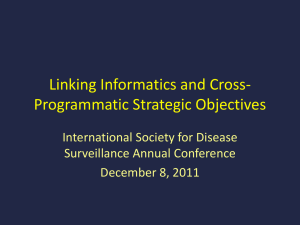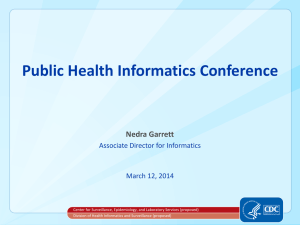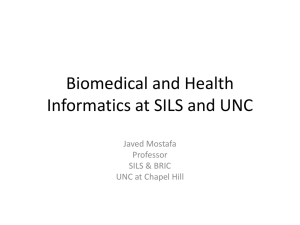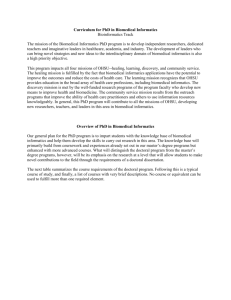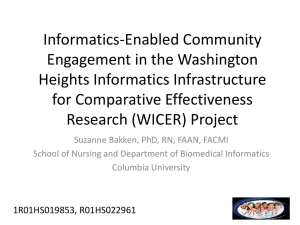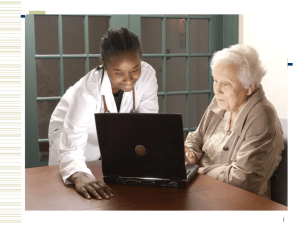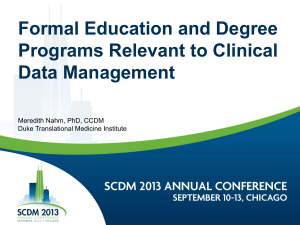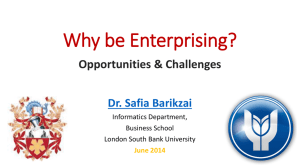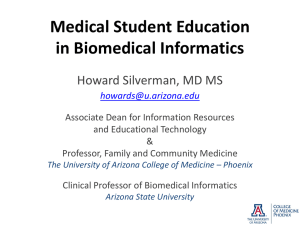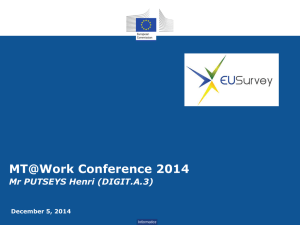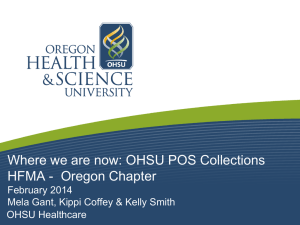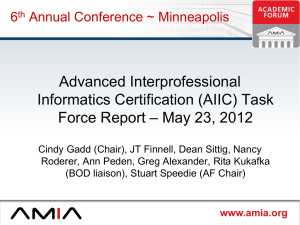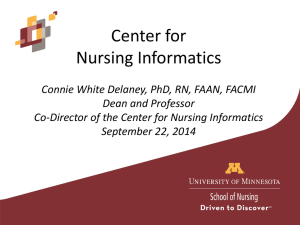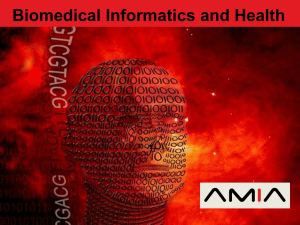Recent Trends in Biomedical and Health Informatics
advertisement
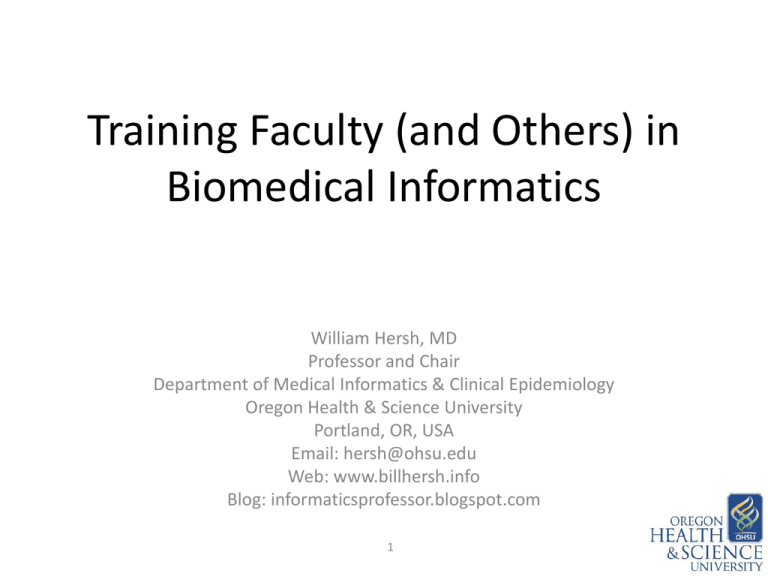
Training Faculty (and Others) in Biomedical Informatics William Hersh, MD Professor and Chair Department of Medical Informatics & Clinical Epidemiology Oregon Health & Science University Portland, OR, USA Email: hersh@ohsu.edu Web: www.billhersh.info Blog: informaticsprofessor.blogspot.com 1 Overview of talk • • • • • Biomedical and health informatics Why we need more faculty What we know about the HIT workforce How we can/should build the HIT workforce The HITECH workforce development program 2 Biomedical and health informatics (BMHI) • “The field that is concerned with the optimal use of information, often aided by the use of technology, to improve individual health, healthcare, public health, and biomedical research” (Hersh, 2009) – It is more about information than technology • We pay inadequate attention to – The growing deluge of data and information (Stead, 2010) – The role of information in medical education and subsequent practice (Shortliffe, 2010) – The critical role and importance of people, including academics, practitioners, and users (Hersh, 2010) 3 Why do we need more BMHI? • In healthcare – Quality – not as good as it could be (McGlynn, 2003; Schoen, 2009; NCQA, 2010) – Safety – IOM “errors report” found up to 98,000 deaths per year (Kohn, 2000); problem persists (Classen, 2011) – Cost – rising costs not sustainable; US spends more but gets less (Angrisano, 2007) – Inaccessible information – missing information frequent in primary care (Smith, 2005) • In other areas – Clinical and translational research (Bernstam, 2009) enabling the learning healthcare system (Friedman, 2010) – Enabling patients, consumers, etc. (Gibbons, 2009) 4 Why do we need more faculty (and others)? • Growing use of BMHI as users – Improving healthcare quality, safety, costeffectiveness, etc. – Meeting meaningful use and other incentives – Communicating with and empower patients – Enabling research, public health, etc. • Increasing career opportunities as – Academics/researchers – research, teaching, and leadership – Professionals/practitioners – new subspecialty and other opportunities 5 How do we train more faculty (and others)? • Historically most BMHI education at graduate level – Informatics is inherently interdisciplinary and there is no single job description or career pathway • More information on programs on AMIA web site – http://www.amia.org/informatics-academic-trainingprograms • Commentary at – http://informaticsprofessor.blogspot.com • Let’s look at – Competencies – Funding opportunities – OHSU experience 6 What competencies should informaticians have? (Hersh, 2009) Health and biological sciences: - Medicine, nursing, etc. - Public health - Biology Competencies required in Biomedical and Health Informatics Management and social sciences: - Business administration - Human resources - Organizational behavior Computational and mathematical sciences: - Computer science - Information technology - Statistics 7 Inventory of competencies for various groups (Hersh, 2010) • Competencies differ by group – Informaticians • Developing, implementing, and evaluating systems • Making optimal use of information – Clinicians … • Applying informatics in delivery of care – Patients • Health information literacy 8 Funding for BMHI training • Mostly self-funded, sometimes at institutional level – e.g., University of Connecticut HSC “grow your own” • Research training historically available through NLM (NIH) training grant program – http://www.nlm.nih.gov/ep/GrantTrainInstitute.html • New opportunities in ONC Workforce Development Program funded under HITECH Act – http://healthit.hhs.gov/portal/server.pt/community/ healthit_hhs_gov__workforce_development_program /3659 9 ONC Workforce Development Program Based on need for 51,000 professionals in 12 workforce roles • Five universities funded to develop curricula for community college programs • OHSU funded to develop curricula and to serve as National Training & Dissemination Center (NTDC) • Nine universities funded, with emphasis on short-term training using distance learning • OHSU funded to enroll trainees in existing programs 10 Experience of the OHSU program • http://www.ohsu.edu/informatics • Graduate-level programs at Certificate, Master’s, and PhD levels – “Building block” approach allows courses to be carried forward to higher levels – Train practitioners and researchers from a wide variety of backgrounds – Mostly self-funded but some funded by NLM, ONC, and others • Two “populations” of students – “First-career” students more likely to be full-time, on-campus, and from variety of backgrounds – “Career-changing” students likely to be part-time, distance, more likely (though not exclusively) from healthcare professions • Many of latter group prefer “a la carte” learning – This has led to the successful 10x10 (“ten by ten”) program that started as OHSU-AMIA partnership (Hersh, 2007; Feldman, 2008) 11 Overview of OHSU graduate programs Masters - Tracks: - Clinical Informatics - Bioinformatics - Thesis or Capstone Graduate Certificate - Tracks: - Clinical Informatics - Health Information Management 10x10 - Or introductory course 12 PhD - Knowledge Base - Advanced Research Methods - Biostatistics - Cognate - Advanced Topics - Doctoral Symposium - Mentored Teaching - Dissertation Challenges • Institutions do not understand informatics – Do not fully appreciate potential synergy with research, clinical enterprise, and/or education • Growing departmental “self-sufficiency” models that discourage collaboration and encourage silos and short-term thinking – Exacerbated by tightening of NIH, state, and other budgets • Informatics departments do not fit in classical basic-clinical divide 13 For more information • Bill Hersh – http://www.billhersh.info • Informatics Professor blog – http://informaticsprofessor.blogspot.com • OHSU Department of Medical Informatics & Clinical Epidemiology (DMICE) – – – – • http://www.ohsu.edu/informatics http://www.youtube.com/watch?v=T-74duDDvwU http://www.informatics-scholarship.info http://oninformatics.com What is Biomedical and Health Informatics? – http://www.billhersh.info/whatis • Office of the National Coordinator for Health IT (ONC) – http://healthit.hhs.gov • American Medical Informatics Association (AMIA) – http://www.amia.org • National Library of Medicine (NLM) – http://www.nlm.nih.gov 14
